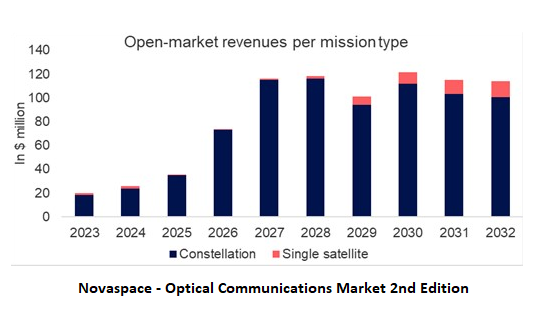Standardization is Key for Enabling Democratization of Optical Communications Technology
Paris, France, May 1, 2024 – Novaspace, a merger between Euroconsult and SpaceTec Partners, a space consulting and market intelligence firm, anticipates that standardization will drive democratization, catalyzing the fast-paced technological evolution of optical communications and the market. Government-supported standardization efforts, such as the SDA program, have been conducted to drive down costs and enable larger adoption of laser communications technology, which for the moment, remains costly.
Several main players are poised to make an entry into the market with SpaceX already announcing their intentions. However, some players may not be compliant with the main laser communications standard. Over the next decade, Laser Communications Terminals (LCT) are anticipated to be internally developed, thereby creating their own standards, by existing Non-Geostationary Orbit (NGSO) constellation operators such as SpaceX’s Starlink, Amazon’s Kuiper and Guowang. Many of these laser terminals will facilitate intersatellite links thereby enhancing NGSO constellation capabilities. This segment is expected to grow to nearly 46,200 in-orbit units by 2032 amounting to an annual market revenue of approximately $800 million. However, the closed market created by the main players presents a challenge for external LCT manufacturers limiting their market access. Nevertheless, the remaining open market is projected to reach approximately 7,300 units in-orbit by 2032 for an annual market revenue of $115 million.
| OPEN MARKET REVENUES PER MISSION TYPE |
 |
Novaspace’s newest Optical Communications Market report predicts that over the next decade, the optical communications market will see cycles driven by satellite constellations as opposed to single satellites. Accelerated revenue growth is anticipated in coming years with 2028 expected to show a plateau in market revenues. Laser terminals may need to explore other sources to sustain growth and development. “As laser communications promises enhanced capabilities, standardization will become more relevant to maintain market expansion and market access,” says Managing Consultant, Xavier Lansel.
Alternate laser terminal applications, such as data relay services facilitated by laser links between space systems, are anticipated to emerge, with forecasts projecting over 750 in-orbit LCTs by the end of the decade. This will necessitate a high level of standardization to enable communication among different systems. Emerging applications such as Direct-to-Earth (DTE) laser communications hold promise for the future despite having to overcome physical constraints, such as atmospheric disturbances, and high costs. DTE laser communications, a technology enabling Quantum Key Distribution (QKD) capabilities, is expected to be commercially available towards the end of the upcoming decade while potentially reaching 430 units in-orbit by 2032.
Optical communications is expected to enable faster, more reliable, and more secure transmission of data in various applications including telecommunications. The optical communications market is currently in a standardization phase, which will play a critical role in driving the advancement and adoption of these emerging technologies, enabling seamless integration into existing infrastructure and facilitating the development of new applications and services. As main players begin to integrate into the market, standardization will ensure operability and scalability. An increase in market revenue will be reflective of this new investment and development. Still many technologies are in a development phase and challenges are expected before full adoption.





